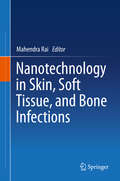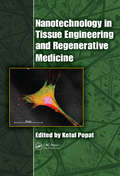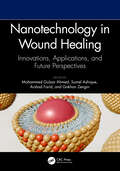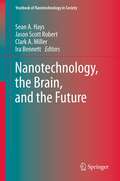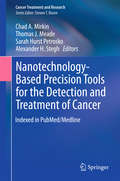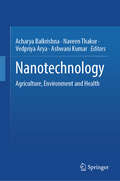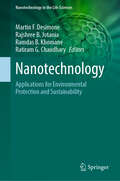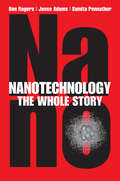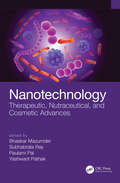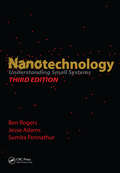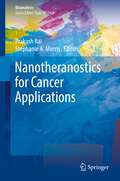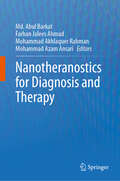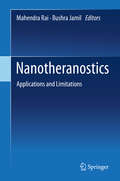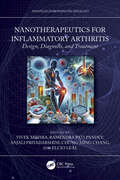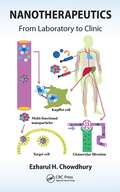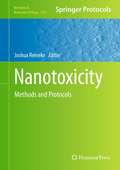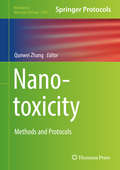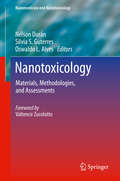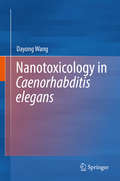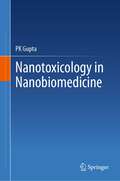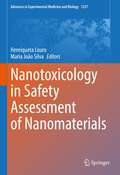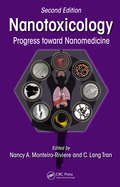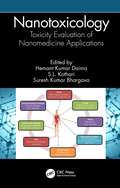- Table View
- List View
Nanotechnology in Skin, Soft Tissue, and Bone Infections
by Mahendra RaiThe main goal of the present book is to deal with the role of nanobiotechnology in skin, soft tissue and bone infections since it is difficult to treat the infections due to the development of resistance in them against existing antibiotics. The present interdisciplinary book is very useful for a diverse group of readers including nanotechnologists, medical microbiologists, dermatologists, osteologists, biotechnologists, bioengineers. Nanotechnology in Skin, Soft-Tissue, and Bone Infections is divided into four sections: Section I- includes role of nanotechnology in skin infections such as atopic dermatitis, and nanomaterials for combating infections caused by bacteria and fungi. Section II- incorporates how nanotechnology can be used for soft-tissue infections such as diabetic foot ulcer and other wound infections; Section III- discusses about the nanomaterials in artificial scaffolds bone engineering and bone infections caused by bacteria and fungi; and also about the toxicity issues generated by the nanomaterials in general and nanoparticles in particular.The readers will be immensely enriched by the knowledge of new and emerging nanobiotechnologies in a variety of platforms.
Nanotechnology in Tissue Engineering and Regenerative Medicine
by Ketul PopatAlthough nanotechnology applied to medicine has a potentially huge impact on drug delivery and tissue engineering, significant challenges need to be resolved before clinically viable nanomedicine or nanobiomedicine therapies will be available. Skillfully edited, with contributions from an expert panel of researchers, Referred to as "nanomedicine" or "nanobiomedicine," the application of nanotechnology to medicine can impact diagnosis, monitoring, and treatment of diseases, as well as the control and understanding of biological systems. Bringing together an unparalleled field of experts, this volume explores various aspects of nanotechnology and its applications in biomedical fields. The book uses an application-oriented approach to relate laboratory-based research to the development of technologies that are easily adaptable to an industry environment, focusing chiefly on drug delivery, tissue engineering, and regenerative medicine.
Nanotechnology in Wound Healing: Innovations, Applications, and Future Perspectives
by Sumel Ashique Arshad Farid Mohammed Gulzar Ahmed Gokhan ZenginThis book comprehensively reviews the role of engineered nanomaterials in wound healing. It presents green synthesized nanomaterials for wound healing and cell growth stimulation and explores the advanced application of nanocellulose. The book highlights innovative approaches like smart 3D printed hydrogels and drug-loaded nanomaterials, as well as natural bioactive compounds encapsulated within nanomaterials. It also covers advancements in nanomaterial-based drug delivery systems and the integration of artificial intelligence in wound healing. Further chapters discuss the role of the immune system and the extracellular matrix in wound healing, strategies to modulate immune responses, and recent advancements in tissue engineering. The book addresses the mechanisms, limitations, and future perspectives of nanomaterials in wound healing, and emphasizes the importance of toxicity studies.
Nanotechnology, the Brain, and the Future
by Jason Scott Robert Sean A. Hays Clark A. Miller Ira BennettOur brain is the source of everything that makes us human: language, creativity, rationality, emotion, communication, culture, politics. The neurosciences have given us, in recent decades, fundamental new insights into how the brain works and what that means for how we see ourselves as individuals and as communities. Now - with the help of new advances in nanotechnology - brain science proposes to go further: to study its molecular foundations, to repair brain functions, to create mind-machine interfaces, and to enhance human mental capacities in radical ways. This book explores the convergence of these two revolutionary scientific fields and the implications of this convergence for the future of human societies. In the process, the book offers a significant new approach to technology assessment, one which operates in real-time, alongside the innovation process, to inform the ways in which new fields of science and technology emerge in, get shaped by, and help shape human societies.
Nanotechnology-Based Precision Tools for the Detection and Treatment of Cancer
by Chad A. Mirkin Thomas J. Meade Sarah Hurst Petrosko Alexander H. SteghThis book discusses emerging nanotechnology-based tools that have the potential to dramatically impact cancer research, diagnostics, and treatment. Cancer is a complex, devastating, and debilitating disease and, although much progress has been made, novel, more effective diagnostic and treatment options are still needed, especially for advanced cancers. The ultimate goal is to detect cancer early and non-invasively and to provide efficacious and targeted precision treatments that cause fewer harmful side effects. This book explains how nanotechnology can exploit the size-, shape-, and composition-dependent properties of nanomaterials to provide novel tools for precision cancer medicine. It will be of interest to researchers and professionals working in the fields of chemistry, biology, materials science and engineering, and medicine who want to learn more about this fascinating and fast-paced area of research.
Nanotechnology: Agriculture, Environment and Health
by Ashwani Kumar Acharya Balkrishna Naveen Thakur Vedpriya AryaThis book presents an update on the state of the art in nanobiology and various nanoparticle synthesis and characterization methods. Further, the application of nanomaterials in agriculture (nanobiofertilizers and nanobiopesticides), environmental remediation (bio-nanoaugmentation), and public health (diagnosis, treatment, and drug delivery) is also a key area of this book. This book serves as a roadmap for researchers to fill various gaps by designing and organizing future research. It offers a crucial reference for academic researchers in nanotechnology, medicine, material science, toxicology, agriculture, environmental science, and biomedical science.
Nanotechnology: Applications for Environmental Protection and Sustainability (Nanotechnology in the Life Sciences)
by Martin F. Desimone Rajshree B. Jotania Ramdas B. Khomane Ratiram G. ChaudharyNanotechnology has the potential to revolutionize the way we address environmental challenges. From water purification, renewable energy, and pollution remediation, nanomaterials offer new and innovative solutions to some of the most pressing problems facing our planet. This book discusses the latest advances in nanotechnology and its potential applications for environmental protection and sustainability. The book covers a wide range of topics, from the fundamental principles of nanotechnology to specific case studies of nanomaterials being used to solve real-world environmental problems. This book is intended for researchers, students, professionals, and policymakers.
Nanotechnology: The Whole Story
by Ben Rogers Jesse Adams Sumita PennathurWinner of an Outstanding Academic Title Award from CHOICE MagazineTransistors using one electron at a time. Seemingly transparent sunscreens made with titanium dioxide particles that block harmful UV rays. Nanometer-sized specks of gold that change color to red and melt at 750 C instead of 1,064 C. Nanotechnology finds the unique properties of thin
Nanotechnology: Therapeutic, Nutraceutical, and Cosmetic Advances (Nutraceuticals Ser. #4)
by Yashwant Pathak Bhaskar Mazumder Subhabrata Ray Paulami PalToday we find the applications of nanotechnology in all spheres of life. Nanotechnology: Therapeutic, Nutraceutical and Cosmetic Advances discusses recent advances in the field, particularly with therapeutics, nutraceuticals and cosmetic sciences. <P><P>Therapeutics is an area which has perhaps benefitted the most, although nanoscience and technology have quietly entered the realms of food science and are playing pivotal roles in the efficient utilization of nutraceuticals. Finally, even before therapeutics came cosmetics and companies started marketing unique products embedding the beneficial and advanced properties enabled by the use of nanostructures. This book highlights trends and applications of this wonderful new technology.
Nanotechnology: Understanding Small Systems, Third Edition (Mechanical and Aerospace Engineering Series)
by Ben Rogers Jesse Adams Sumita PennathurAn Accessible, Scientifically Rigorous Presentation That Helps Your Students Learn the Real StuffWinner of a CHOICE Outstanding Academic Book Award 2011"� takes the revolutionary concepts and techniques that have traditionally been fodder for graduate study and makes them accessible for all. � outstanding introduction to the broad field of nanotech
Nanotheranostics for Cancer Applications (Bioanalysis #5)
by Prakash Rai Stephanie A. MorrisThis book is the first to focus specifically on cancer nanotheranostics. Each of the chapters that make up this comprehensive volume is authored by a researcher, clinician, or regulatory agency member known for their expertise in this field. Theranostics, the technology to simultaneously diagnose and treat a disease, is a nascent field that is growing rapidly in this era of personalized medicine. As the need for cost-effective disease diagnosis grows, drug delivery systems that can act as multifunctional carriers for imaging contrast and therapy agents could provide unique breakthroughs in oncology. Nanotechnology has enabled the development of smart theranostic platforms that can concurrently diagnose disease, start primary treatment, monitor response and initiate secondary treatments if required. In oncology, chemotherapeutics have been routinely used. Some drugs have proven effective but all carry risks of adverse side effects. There is growing interest in using remotely triggered drug delivery systems to limit cytotoxicity in the diseased area. This book reviews the use of theranostic nanoparticles for cancer applications over the past decade. First, it briefly discusses the challenges and limitations of conventional cancer treatments, and presents an overview of the use of nanotechnology in treating cancer. These introductory chapters are followed by those exploring cancer diagnosis and a myriad of delivery methods for nanotherapeutics. The book also addresses multifunctional platforms, treatment monitoring, and regulatory considerations. As a whole, the book aims to briefly summarize the development and clinical potential of various nanotheranostics for cancer applications, and to delineate the challenges that must be overcome for successful clinical development and implementation of such cancer theranostics.
Nanotheranostics for Diagnosis and Therapy
by Farhan Jalees Ahmad Md. Abul Barkat Mohammad Azam Ansari Mohammad Akhlaquer RahmanThis book provides an updated account of recent advancements in the field of nanotechnology-based theranostics with special emphasis on their application in the diagnosis and treatment of various types of cancer and neurological diseases. The book is divided into two sections; the first section provides an introduction to the nanoscale theranostics & radiopharmaceuticals. The second section highlights the importance of nanoscale theranostics in disease diagnosis & treatment. It presents the potential of nanotechnology for developing nanomedicine and nanotheranostics for the diagnosis and treatment of a variety of illnesses. Further, the book discusses the usefulness of theranostic nanoparticles in the diagnosis of disease, identification of location, and stage, and in providing information about the therapy response. In addition, the book focuses on the clinical applications of nanomaterial radiolabeling in nuclear imaging of cancer and other illness. Towards the end, the bookexamines the toxicity, regulatory protocols, and future aspects of clinical applications of theranostics. This book is an invaluable source for academicians and industrial scientists working in multiple healthcare fields like pharmaceutical and biological sciences, life sciences, biotechnology, biomedical engineering, and nanobiotechnology.
Nanotheranostics: Applications and Limitations
by Mahendra Rai Bushra JamilThis book is specifically designed to provide information about various nanocarriers currently developed under the emerging field of nanotheranostics for a sustained, controlled, and targeted co-delivery of diagnostic and therapeutic agents. Diverse theranostic applications of nanotechnology and their limitations are also addressed. It integrates nanobiotechnology with theranostic applications. The combined term nanotheranostics has diverse application particularly in chemotherapy and other infectious diseases.Among other topics addressed are antimicrobial resistance, targeting intra-cellular pathogens, viruses and bacteria, chemotherapy, cancer therapeutics, and inflammatory disorders. This interdisciplinary volume is essential for a diverse group of readers including nanotechnologists, microbiologists, biotechnologists, bioengineering and bioprocess industry.
Nanotherapeutics for Inflammatory Arthritis: Design, Diagnosis, and Treatment (Advances in Bionanotechnology)
by Vivek Mishra Anjali Priyadarshini Ramendra Pati Pandey Chung-Ming Chang Elcio LealNanotherapeutics for Inflammatory Arthritis: Design, Diagnosis, and Treatment highlights nanobiotechnology and its therapeutic applications in the field of inflammatory arthritis, the interaction of nanomaterials in the biological systems, and clinical development of nanomedicines. It also covers the discovery of personalized therapeutics, diagnostics, and nanoparticular delivery systems, the role of bioinformatics nanobiotechnology in personalized oncology. The use of nanosensors for the detection and current challenges in the development of personalized medicine is explained including recent nanotechnology-based strategies.Features: Covers all the fundamental information about nanotechnology and inflammatory arthritis. Highlights the interaction of nanomaterials in the biological systems, and the clinical development of nanomedicines for inflammatory arthritis. Explores the discovery of personalized therapeutics, diagnostics, and nanoparticle delivery systems. Reviews the current challenges in the development of personalized medicine as well as translation of nanomedicine with combination therapy. Discusses the toxicology of using nanomedicines and the risks associated with the use of these nanomedicines. This book is aimed at researchers and professionals in nanotechnology, biomaterial, drug delivery, and inflammatory arthritis.
Nanotherapeutics: From Laboratory to Clinic
by Ezharul Hoque ChowdhuryThe emergence of nanotherapeutics is attributable to the integration of nanotechnology, recombinant DNA technology, and synthetic organic chemistry with medicine for treating critical human diseases in a more efficient and specific molecular approach than therapy with conventionally-designed and formulated drugs. Nanotherapeutics: From Laboratory t
Nanotherapy for Brain Tumor Drug Delivery (Neuromethods #163)
by Vivek Agrahari Anthony Kim Vibhuti AgrahariThis volume provides a guide on nanoformulations and other drug delivery approaches for both academic and industry scientists. The chapters in this book cover diverse topics and techniques in nanoparticle drug delivery, gene therapy, neurosurgical brain implant, exosomes, MRI-guided focused ultrasound (MRgFUS), and advanced preclinical glioblastoma multiforme animal models. Some chapters discuss state-of-the-art and innovative nanomedicines for glioblastoma, surface-modified nanoparticle drug carriers for brain cancer treatment, focused ultrasound (FUS)-mediated blood-brain barrier disruption for enhanced drug delivery to brain tumors; gene therapy delivery approaches to treat brain cancer, and a liposome-template hydrogel nanoparticles (LHNPs) as a powerful CRISPR/Cas9 delivery vehicle. In the Neuromethods series style, chapters include the kind of detail and key advice from the specialists needed to get successful results in your laboratory. Cutting-edge and thorough, Nanotherapy for Brain Tumor Drug Delivery is a valuable resource for the scientific community working on this important therapeutic field, and will help fast-track the clinical translation of revolutionary nanotechnologies for treating brain tumors.
Nanotoxicity
by Joshua ReinekeThe field of nanotechnology has developed very rapidly over the past decade lending great promise to medical applications in drug delivery, therapeutics, and biological imaging. Due to the great promise, rapid development, and broad application of nanomaterials, it is imperative that researchers from development through application seek a thorough understanding of nanotoxicity. Nanotoxicity: Methods and Protocols address the special considerations when applying toxicity studies to nanomaterials and detail newly developed methods for the study of nanotoxicity. These diverse methods span in vitro cell culture, model tissues, in situ exposure, in vivo models, analysis in plants, and mathematical modeling, proving to be relevant to pharmaceutical scientists, material scientists, bioengineers, toxicologists, environmentalists, immunologists, and cellular and molecular biologists, to name a few. As part of the highly successful Methods in Molecular BiologyTM, chapters include introductions to their respective topics, lists of the necessary materials and reagents, step-by-step, readily reproducible laboratory protocols, and tips on troubleshooting and avoiding known pitfalls. Comprehensive and cutting-edge, Nanotoxicity: Methods and Protocols aims to diversify the capabilities of current researchers involved in nanotoxicology and to enable researchers in related fields to expand their knowledge of how nanomaterials interface with the biological environment.
Nanotoxicity: Methods And Protocols (Methods in Molecular Biology #1894)
by Qunwei ZhangThis volume explores the latest techniques used to investigate nanotoxicity. The protocols covered in this book range from routine nanotoxicity assays to genomic and proteomic approaches in vivo and in vitro. The chapters discuss specific topics such as preparation and utilization of 3D human liver microtissue models; assessment of ovarian granulosa cells with exposure to nanoparticles; DNA methylation analysis; evaluation of genotoxicity of nanoparticles in mouse models; and studying nanotoxicity using embryonic zebrafish. Written in the highly successful Methods in Molecular Biology series format, chapters include introductions to their respective topics, lists of the necessary materials and reagents, step-by-step, readily reproducible laboratory protocols, and tips on troubleshooting and avoiding known pitfalls.Cutting-edge and practical, Nanotoxicity: Methods and Protocols is a valuable resource for researchers and postgraduate students in the fields of toxicology, environmental science, pharmacological sciences, and clinical medicine. This volume also serves as a starting point for researchers interested in learning more about this developing field.
Nanotoxicology
by Nelson Durán Silvia S. Guterres Oswaldo L. AlvesThis book takes a systematic approach to nanotoxicology and the developing risk factors associated with nanosized particles during manufacture and use of nanotechnology. Beginning with a detailed introduction to engineered nanostructures, the first part of the book presents concepts and definitions of nanomaterials from quantum dots to graphene to fullerenes, with detailed discussion of functionalization, stability, and medical and biological applications. The second part critically examines methodologies used to assess cytotoxicity and genotoxicity. Coverage includes interactions with blood (erythrocytes), combinatorial and microarray techniques, cellular mechanisms, and ecotoxicology assessments. Part three describes cases studies both in vitro and in vivo for specific nanomaterials including solid lipid nanoparticles and nanostructured lipid carriers and metallic nanoparticles and metallic oxides. New information is also presented on toxicological aspects of poloxamers and polymeric nanoparticles as drug carriers as well as size effects on cytotoxicity and genotoxicity. Didactic aspects are emphasized in all chapters, making the book suitable for a broad audience ranging from advanced undergraduate and graduate students to researchers in academia and industry. In all, Nanotoxicology: Materials, Methodologies, and Assessments will provide comprehensive insight into biological and environmental interactions with nanostructures. Provides an introduction to nanostructures actually in use Describes cyto- and genotoxicity methodologies, and assesses their performance in comparison to common toxicity assays Discusses the relation of cytotoxicity and genotoxicity to ecotoxicity Presents a range of applications, from biogenic silver nanoparticles to poloxamers as drug-delivery systems, reflecting the expanding applications of nanotechnology
Nanotoxicology in Caenorhabditis elegans
by Dayong WangThis book focuses on the toxicity of engineered nanomaterials (ENMs) and their underlying physicochemical, cellular, physiological, and molecular mechanisms. Further, it covers ENMs’ translocation and their targeted organ toxicology, and discusses chemical and pharmacological strategies used to combat nanotoxicity. Engineered nanomaterials (ENMs) are defined as materials with one or more dimensions of less than 100 nm, and have shown considerable promise in several areas of development. At the same time, the potential toxicity of ENMs for human health and environmental organisms is increasingly attracting attention. In addition to the typical properties of model animals, Caenorhabditis elegans is extremely sensitive to environmental toxicants, which makes it the ideal in vivo assay system for toxicological studies. C. elegans has been widely used in toxicity assessment and toxicological studies of environmental toxicants and stresses. This book provides a comprehensive summary of nanotoxicology research on C. elegans.
Nanotoxicology in Humans and the Environment (Molecular and Integrative Toxicology)
by Jamie R. Lead Shareen H. Doak Martin J. D. CliftThe book covers the area of ‘Nanotoxicology’ but primarily from the point of view of nanotoxicology at the interface with other disciplines including human toxicology; environmental toxicology; characterization, dose and transformations; regulation; public and elite group perceptions; and interactions with innovation.Nanotoxicology in Humans and the Environment is written for researchers in nanotoxicology in academia, industry, government, and research students. Given the rapid development, the maturing of the discipline and its importance in current regulation and industry development (eg REACH, TSCA), the book is very timely.
Nanotoxicology in Nanobiomedicine
by PK GuptaThis book provides that knowledge needed to introduce individuals to the most important research and content on nanotoxicology in nanobiomedicine. Nanotechnology is helping to considerably improve, even revolutionize many technology and industry sectors: information technology, homeland security, medicine, transportation, energy, food safety, and environmental science, among many others. There is an urgent need for a general reference textbook that presents the most recent information on the toxicity and its effects in all these sectors, biomedicine in particular. It includes historical information, nanotoxicology by subject area and or disease, sources of nanomaterials, drug delivery systems and more. Scientists, researchers, and students in all fields that use nanotechnology will find this book essential reading.
Nanotoxicology in Safety Assessment of Nanomaterials (Advances in Experimental Medicine and Biology #1357)
by Henriqueta Louro Maria João SilvaSince its advent, nanotechnologies are considered key enabling technologies that take advantage of a wide array of nanomaterials (NMs) for biomedical and industrial applications generating significant societal and economic benefits. However, such innovation increases human exposure to these substances through inhalation, ingestion or dermal contact raising public health concerns. Furthermore, the NMs’ specific physicochemical properties, that confer them unique beneficial characteristics, can also elicit nano-bio interactions leading to toxicity and concerns for public health. In addition, such properties can be affected by the surrounding matrix, particularly when incorporated in complex matrices such as food products, leading to secondary features potentially more relevant than primary characteristics for determining their toxicological outcome. These nano specific issues raise the question of whether the NMs may produce adverse outcomes that are not accounted for when using conventional toxicological approaches to assess their safety. Such uncertainties about the safety of NMs for human health and the environment may hamper a faster and more widespread exploration of their potentials. In response, the NMs definition has evolved, and nanotoxicology has developed towards new and more integrative approach methods to support regulatory and policy actions. This book provides a perspective on recent developments in the synthesis, application, and characterization of NMs and the related nanotechnologies, focusing on nanotoxicology for their accurate safety assessment early in the product development stage. The use of complex in vitro models, including multicellular systems and organoids, and “omics-based” approaches, such as transcriptomics or epigenomics, have greatly contributed to an in-depth understanding of the cellular and molecular mechanisms behind some NMs toxicity. Such mechanistic knowledge is equally addressed in this book and has set the basis for a predictive nanotoxicology approach building on adverse outcome pathways. In addition, considering the knowledge provided by the above-mentioned approaches, insights into risk assessment, standardization, and regulation of NMs are also included. Incorporating adequate nanosafety assessment early in the life-cycle of NMs will allow the implementation of the safe and sustainable-by-design paradigm enabling safety to keep pace with innovation. Chapters 10 and 15 are available open access under a Creative Commons Attribution 4.0 International License via link.springer.com.
Nanotoxicology: Progress toward Nanomedicine, Second Edition
by Prasen Palvankar Joop Koster C. Lang Tran Nancy A. Monteiro-RiviereSince the first publication of this book in 2007, the field of nanoscience and nanomedicine continues to grow substantially. This second edition, Nanotoxicology: Progress toward Nanomedicine, enlists internationally recognized experts to document the continuing development and rationale for the safe design of engineered nanomaterials (ENM). This in
Nanotoxicology: Toxicity Evaluation of Nanomedicine Applications
by Hemant Kumar Daima S. L. Kothari Suresh Kumar BhargavaThe field of nanomedicine has risen quickly due to the increasing number of designer-made nanomaterials. These nanomaterials have the potential to manage diseases and change the way medicine is currently studied. However, the increased practice of using nanomaterials has shed light on how many concepts of nanomedicine and nanotoxicity have been overlooked. Nanotoxicology: Toxicity Evaluation of Nanomedicine Applications addresses the existing gaps between nanomedicine and nanotoxicity. This book also brings together up-to-date knowledge on advances toward safe-by-design nanomaterials and existing toxicity challenges. This book delivers a comprehensive coverage in the field with fundamental understanding, serving as a platform to convey essential concepts of nanotoxicology and how these concepts can be employed to develop advanced nanomaterials for a range of biomedical applications. This book is an effort to answer some of the thoughtful nanotoxicological complications and their auspicious probable solutions with new approaches and careful toxicity assessment. Key Features: Reveals novel nanoscale approaches, toxicity assessment, and biomedical applications Includes importance of nanotoxicity concepts in developing smart nanomaterials Highlights unique contributions and "A to Z" aspects on the state-of-the-art from global leaders Offers a complete package to learn fundamentals with recommendations on nanomaterials toxicity and safe-by-design nanomedicines Nanotoxicology: Toxicity Evaluation of Nanomedicine Applications illuminates the high potential of many innovative nanomaterials, ultimately demonstrating them to be promising substitutes for available therapies that can be effectively used in fighting a myriad of biomedical complications. Further, this book reports legal, ethical, safety, and regulatory issues associated with nanomaterials, which have often been neglected, if not overlooked in literature and limiting clinical translation at nanoscale level. It will equip readers with cutting-edge knowledge of promising developments in nanomedicine and nanotoxicology, along with potential future prospects.
